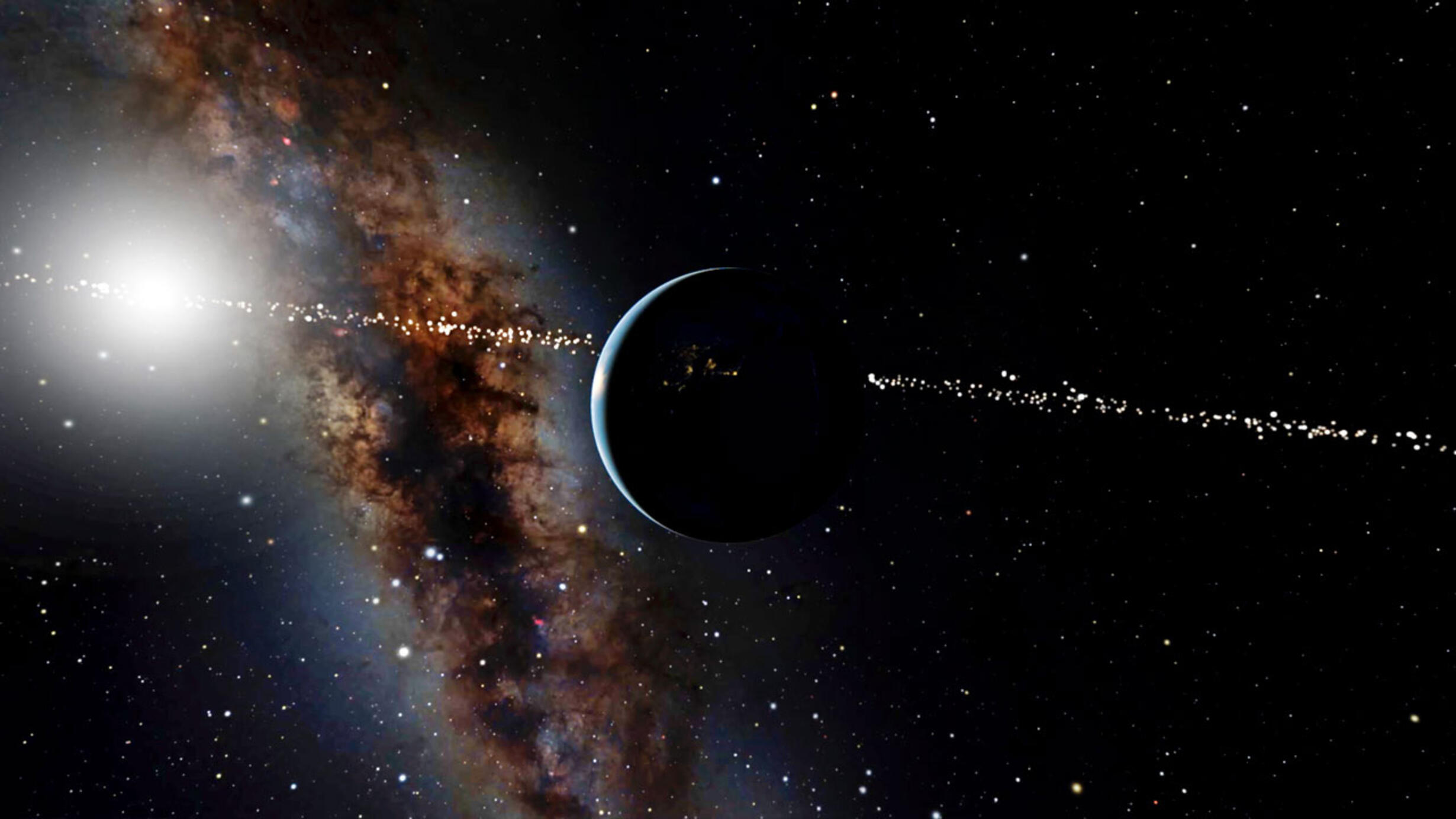 A view of the Earth and Sun from thousands of miles above our planet, with stars in position to see Earth transiting around the Sun brightened and the Milky Way visible on the left.
A view of the Earth and Sun from thousands of miles above our planet, with stars in position to see Earth transiting around the Sun brightened and the Milky Way visible on the left.Open Space/ © AMNH
A new study reverses the traditional vantage point astronomers use to find planets in the Milky Way by asking not “what can we see?” but “what can see us?”
An astronomer duo that includes a researcher from the Museum and a researcher from Cornell University have identified more than 2,000 nearby star systems that could find Earth simply by watching our world cross our Sun. The study, which focuses on stars within 326 light-years of us, is published today in the journal Nature.
“One might imagine that there are worlds beyond Earth that have already detected us and are wondering if they are alone in the cosmos,” said co-author Jackie Faherty, a senior scientist in the Museum’s Department of Astrophysics. “This catalog is an intriguing thought experiment for which one of our neighbors might be able to find and study Earth.”
Outside View of Earth's Transit
[Earth in space. The Sun is the brightest light against the background of a star field.]
Seven star systems that can detect Earth transit the Sun are already known to host one or more exoplanets.
[Camera pulls out farther into space to show star systems largely grouped into a circular plane.]
Seventy-five star systems are close enough to our solar system that Earth's broadcast radio waves have washed over them.
One might imagine there are worlds beyond Earth that have already detected us and are wondering if they are alone in the cosmos.
[Our perspective moves around the circular group of star systems and pulls out further.]
This catalog is an intriguing thought experiment about which one of our neighbors might be able to find and study Earth.
Most known exoplanets have been discovered using the transit method, by detecting a planet as it passes between a star and its observer. When this happens, the light of the star is dimmed very slightly, which can reveal clues about the makeup of the planet’s atmosphere.
“We wanted to know which stars have the right vantage point to see Earth, as it blocks the Sun’s light,” said co-author Lisa Kaltenegger, professor of astronomy and director of Cornell’s Carl Sagan Institute. “And because stars move in our dynamic cosmos, this vantage point is gained and lost.”
Faherty and Kaltenegger used data from the European Space Agency’s Gaia catalog to determine which stars enter and exit the “Earth Transit Zone,” or ETZ, and for how long.
They found 1,715 star systems that could have spotted Earth since human civilization blossomed about 5,000 years ago, and 319 more star-systems that will be added over the next 5,000 years. Of these, 75 objects lie within about 100 light-years of the Sun and have been in the ETZ since the Earth began broadcasting into space. Seven of the star systems in the catalog are already known to host exoplanets.
“Each one of these worlds has had or will have an opportunity to detect Earth just as we have found thousands of worlds orbiting other stars through the transit technique,” Faherty said.
Examples of known exoplanet systems in the study include:
- The Ross 128 system, which has a red dwarf host star located in the Virgo constellation. It is about 11 light-years away and is the second-closest system with an Earth-sized exoplanet (about 1.8 times the size of our planet). Any inhabitants of this exoworld could have seen Earth transit our own Sun for 2,158 years, starting about 3,057 years ago; they lost their vantage point about 900 years ago.
- The Trappist-1 system, which at 45 light-years from Earth, hosts seven transiting Earth-size planets–four of them in the temperate, habitable zone of that star. While scientists have discovered the exoplanets around Trappist-1, they won’t be able to spot us until their motion takes them into the ETZ in 1,642 years. Potential Trappist-1 system observers will be able to see Earth for 2,371 years.
- Teegarden’s Star, the 25th closest system to our Sun at about 12.5 light years away, hosts two non-transiting Earth-mass worlds. It will enter the ETZ in 29 years for 410 years
“Our analysis shows that even the closest stars generally spend more than 1,000 years at a vantage point where they can see Earth transit,” Kaltenegger said. “If we assume the reverse to be true, that provides a healthy timeline for nominal civilizations to identify Earth as an interesting planet.”